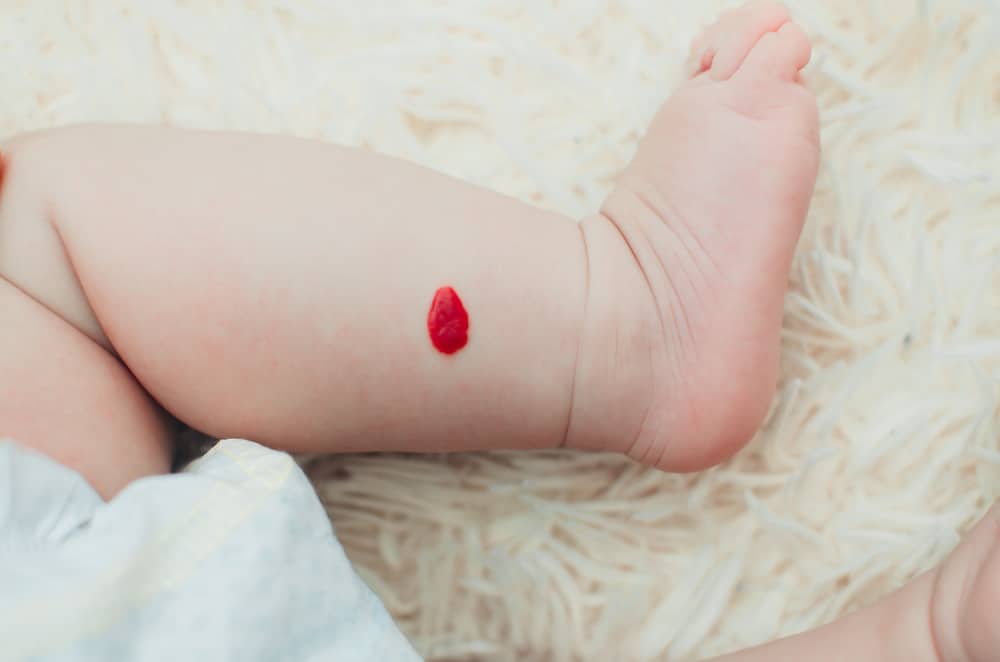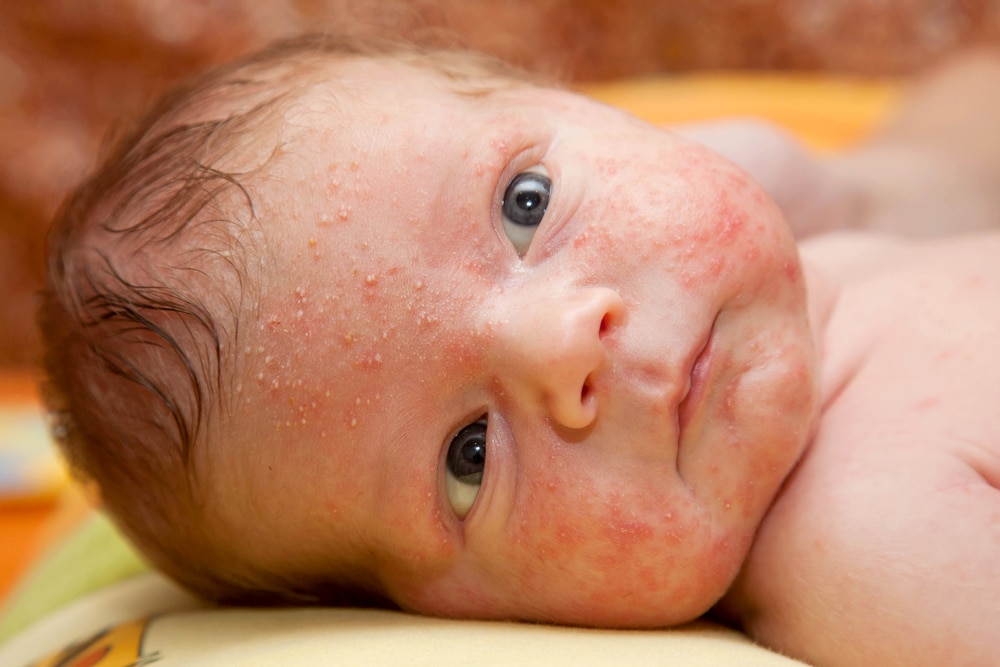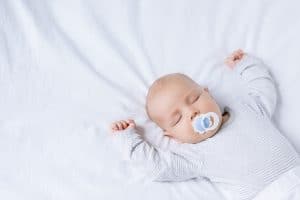
Common baby rashes – how do you know what’s what? And how do we know when to worry? If your little one has a rash, lump or bump, here’s what you need to know! Baby Hints & Tips resident GP, Dr Melissa Homewood answers all your concerns about newborn skin conditions.
As you get to know every millimetre of your baby, it can be surprising (and sometimes unsettling) to find blotches and blemishes on their skin. Let’s explore what your little one could be showing signs of from common baby rashes to allergy or birthmarks.
There are many relatively common transient skin eruptions that are seen in newborn babies. Most of these need no investigation or management and resolve on their own over a period of days to months with no long term effects. Often the issue is largely cosmetic.
Some conditions can mean an underlying disorder or infection – these need treatment, so it is always best to consult with your doctor to be sure.

Baby with Neonatal Acne.
Common baby rashes & newborn skin conditions with colour changes:
- Cutis marmorata
This is a mottling of the skin that can be seen in newborn babies. It is due to the blood vessel’s response to the cold and usually settles with warming. Reasonably common in the early weeks but can persist. Really pronounced or persistent cases can sometimes be due to other underlying disorders. You can see pictures of this common baby rash here.
- Harlequin colour change
This can be quite concerning to parents (happens in around 10% of babies) – it occurs when the baby is lying on its side (e.g. feeding) and the lower half goes red while the upper half goes quite pale. It can happen suddenly and persist for seconds to minutes before settling with movement/crying. It often goes unnoticed, as babies are often dressed or wrapped in those early days. It may continue for the first couple of weeks of life and is thought to be due to the immaturity of the part of the baby’s brain that controls blood vessels.
- Acrocyanosis
This is very common in newborn babies – it describes the appearance of the feet and hands being symmetrically blue/purple. It usually settles with warming and resolves within the first month.

Image of Acrocyanosis by Dr John Kevin Dayao.
Common baby rashes & newborn skin conditions with rashes & eruptions:
- Erythema toxicum neonatorum or toxic erythema of the newborn
The name sounds quite scary but this extremely common rash (affecting at least 50% of babies) is harmless and requires no treatment. It is usually seen in term rather than premature babies. Typically the rash, which appears as red marks on the skin with little bumps or even pustules develops in the first few days of life and lasts a few days, sometimes waxing and waning a bit before settling. In some cases it can appear at up to two weeks of life or recur over the first few weeks. It affects the whole body but not usually the palms or soles. It doesn’t bother the baby at all, although it can look quite angry – often nastier than it actually is. Some describe it as “flea bites” which is quite a good description. See more images of this common baby rash here. - Milia
These harmless tiny white spots commonly affect newborn babies (40-50% of babies) and disappear on their own by around four weeks. They are tiny cysts containing a skin protein called keratin. They are often seen on the nose but also on the face/scalp/body. When they are seen on the gums they are called “Epstein pearls”. You can see pictures of milia on a baby’s nose here.

Baby with Milia on Cheeks.
- Miliara
This is a rash caused by blockage of sweat ducts, so is more common in warmer climates. There are a few versions depending on how deep the blockage is. More superficial blockages tend to cause little thin blister-like spots (sometimes they almost look like little water droplets on the skin) – this is called miliara crystallina. Deeper blockages appear as red and inflamed bumps– this is called miliara rubra or commonly known as prickly heat/sweat rash. It usually affects the forehead, neck, and parts of the body covered by clothes. Miliara usually needs no treatment and tends to settle with cooling measures and allowing the skin to breathe. Images of miliara are here. - Neonatal acne
There are variations of this ranging from mild to more severe forms with pus filled pimples. It starts in the first few weeks of life (commonly week two to three) due to the activity of the oil producing glands in the skin. It often affects the forehead and cheeks the worst. Mum’s hormones probably play a role and in some cases a yeast (called “Malassezia”) that lives on the skin plays a role. It usually settles in one to three months and doesn’t scar. Treatment is not necessary and it doesn’t tend to bother the baby (the issue is largely cosmetic). Occasionally anti-fungal creams can be used if severe and treatment is requested.
Common baby rashes & newborn skin conditions: Cradle cap or seborrhoeic dermatitis
This is a greasy, scaly rash that commonly affects the scalp of babies. Possible causes of cradle cap include:
- Include overactive oil producing glands
- Mum’s hormones
- Yeasts that live on the skin.
Cradle cap is often noticed in the first month of life. As well as the scalp, the ears, neck, face (especially around the eyebrows) and nappy area can also be affected. It doesn’t tend to bother the baby and is usually not very itchy. Most of the time, it settles on its own (but often over months to a year or so).
Treatment of cradle cap can include:
- It can be treated and responds quite well but it is fairly common for it to recur.
- Simple treatment consists of gentle shampoos/oils to soften the scales and gentle brushing to remove them.
- For severe cases mild anti-fungal and/or steroid creams can be used to settle cradle cap down (particularly in the nappy area/neck/behind ears).

Common baby rashes & newborn skin conditions: Birthmarks
- Mongolian spot
This is a flat grey-ish/blue patch that is usually found on the bottom/back. They sometimes look a bit like a bruise. It is more common in Asian, Hispanic or African babies. It is harmless, requires no treatment and usually fades with age (gone by adolescence). You can see images of Mongolian Spot here.
- Haemangioma or Strawberry naevus
These are a growth of blood vessels that develop just after birth. Most of the time they are on the head or neck and usually grow (sometimes quite rapidly) for the first few months before most then regress (shrink) back. Flat spots often disappear without treatment, but big raised ones can leave a mark/scar. Because they usually improve over time, often no treatment is required. However, if they are very large, ulcerated or are near important structures (e.g. eyes, nose, airway) that might be affected by their growth they may need treatment (e.g. medication/gels/laser).

Haemangioma or Strawberry Naevus mark on baby’s leg.
- Salmon patch or stork bites
Very common, this is a small flat patch of pink/red skin present at birth. It is often found at the back of the neck (“Stork bite”), between the eyebrows or on the eyelids. They are often more obvious during episodes of crying. They usually disappear over the first 12 months. Sometimes stork marks can remain throughout life. See images of salmon patch or stork bites here.
- Port wine stain
These are much less common. Port wine stain birthmarks are a large flat purplish mark on the skin. They are usually on the face although can be anywhere on the body (although generally only on one side). Some fade but others do not and can even darken over time. Treatment of port wine stains can be done with laser where there is cosmetic concern. There can be some syndromes associated with these birth marks so seek medical advice for more information.














